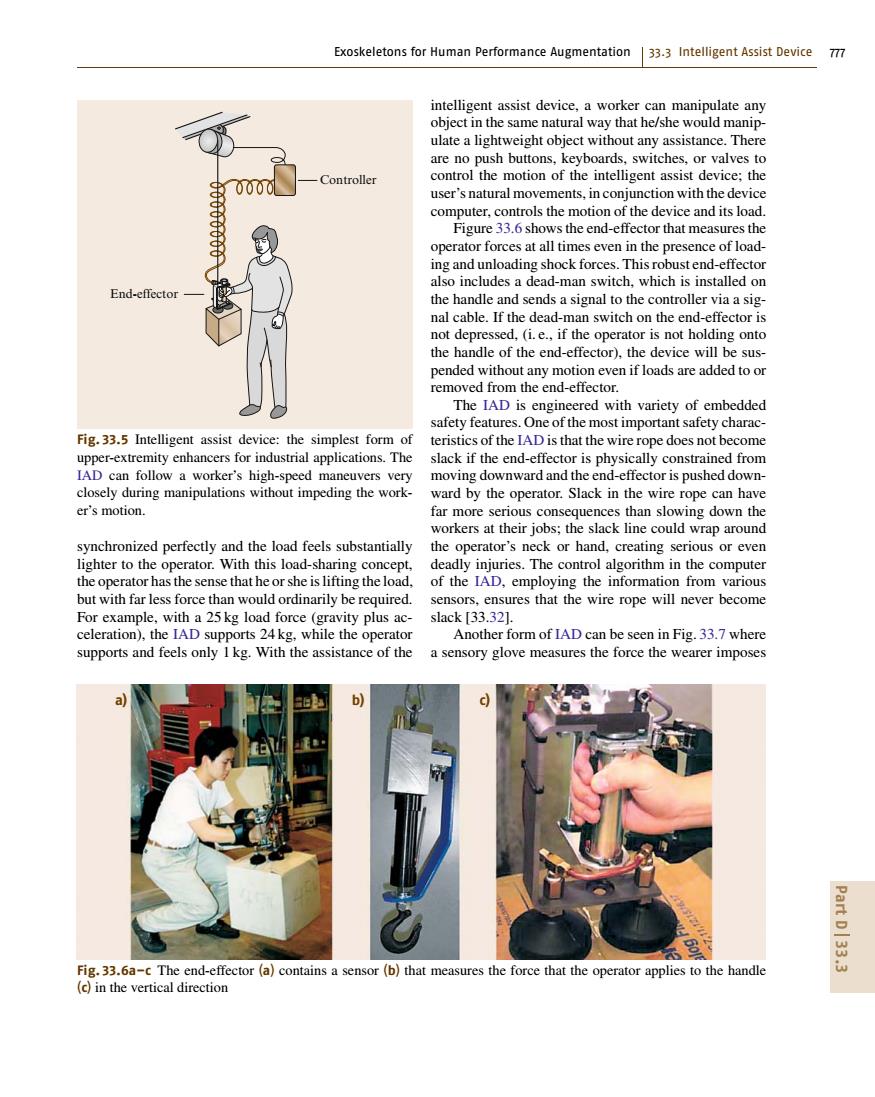正在加载图片...

Exoskeletons for Human Performance Augmentation 33.3 Intelligent Assist Device 777 intelligent assist device,a worker can manipulate any object in the same natural way that he/she would manip- ulate a lightweight object without any assistance.There are no push buttons,keyboards,switches,or valves to 000 Controller control the motion of the intelligent assist device:the user's natural movements,in conjunction with the device computer,controls the motion of the device and its load. Figure 33.6 shows the end-effector that measures the operator forces at all times even in the presence of load- ing and unloading shock forces.This robust end-effector also includes a dead-man switch,which is installed on End-effector the handle and sends a signal to the controller via a sig- nal cable.If the dead-man switch on the end-effector is not depressed,(i.e.,if the operator is not holding onto the handle of the end-effector),the device will be sus- pended without any motion even if loads are added to or removed from the end-effector. The IAD is engineered with variety of embedded safety features.One of the most important safety charac- Fig.33.5 Intelligent assist device:the simplest form of teristics of the IAD is that the wire rope does not become upper-extremity enhancers for industrial applications.The slack if the end-effector is physically constrained from IAD can follow a worker's high-speed maneuvers very moving downward and the end-effector is pushed down- closely during manipulations without impeding the work- ward by the operator.Slack in the wire rope can have er's motion. far more serious consequences than slowing down the workers at their jobs;the slack line could wrap around synchronized perfectly and the load feels substantially the operator's neck or hand,creating serious or even lighter to the operator.With this load-sharing concept, deadly injuries.The control algorithm in the computer the operator has the sense that he or she is lifting the load,of the IAD,employing the information from various but with far less force than would ordinarily be required.sensors,ensures that the wire rope will never become For example,with a 25kg load force (gravity plus ac-slack [33.32]. celeration),the IAD supports 24kg,while the operator Another form of IAD can be seen in Fig.33.7 where supports and feels only I kg.With the assistance of the a sensory glove measures the force the wearer imposes Part D33.3 Fig.33.6a-c The end-effector(a)contains a sensor (b)that measures the force that the operator applies to the handle (c)in the vertical directionExoskeletons for Human Performance Augmentation 33.3 Intelligent Assist Device 777 End-effector Controller Fig. 33.5 Intelligent assist device: the simplest form of upper-extremity enhancers for industrial applications. The IAD can follow a worker’s high-speed maneuvers very closely during manipulations without impeding the worker’s motion. synchronized perfectly and the load feels substantially lighter to the operator. With this load-sharing concept, the operator has the sense that he or she is lifting the load, but with far less force than would ordinarily be required. For example, with a 25 kg load force (gravity plus acceleration), the IAD supports 24 kg, while the operator supports and feels only 1 kg. With the assistance of the a) b) c) Fig. 33.6a–c The end-effector (a) contains a sensor (b) that measures the force that the operator applies to the handle (c) in the vertical direction intelligent assist device, a worker can manipulate any object in the same natural way that he/she would manipulate a lightweight object without any assistance. There are no push buttons, keyboards, switches, or valves to control the motion of the intelligent assist device; the user’s natural movements, in conjunction with the device computer, controls the motion of the device and its load. Figure 33.6 shows the end-effector that measures the operator forces at all times even in the presence of loading and unloading shock forces. This robust end-effector also includes a dead-man switch, which is installed on the handle and sends a signal to the controller via a signal cable. If the dead-man switch on the end-effector is not depressed, (i. e., if the operator is not holding onto the handle of the end-effector), the device will be suspended without any motion even if loads are added to or removed from the end-effector. The IAD is engineered with variety of embedded safety features. One of the most important safety characteristics of the IAD is that the wire rope does not become slack if the end-effector is physically constrained from moving downward and the end-effector is pushed downward by the operator. Slack in the wire rope can have far more serious consequences than slowing down the workers at their jobs; the slack line could wrap around the operator’s neck or hand, creating serious or even deadly injuries. The control algorithm in the computer of the IAD, employing the information from various sensors, ensures that the wire rope will never become slack [33.32]. Another form of IAD can be seen in Fig. 33.7 where a sensory glove measures the force the wearer imposes Part D 33.3